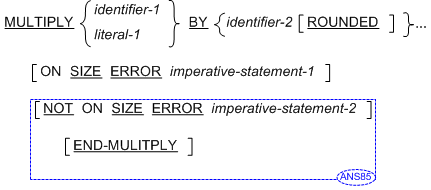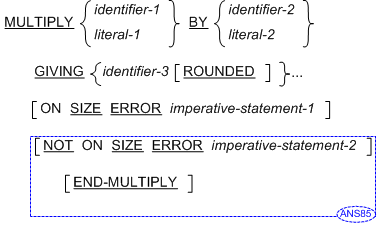The MULTIPLY Statement
The MULTIPLY statement causes numeric data items to be multiplied and sets the values of data items equal to the results.
General Formats for Format 1

General Formats for Format 2

Syntax Rules for All Formats
- Each identifier must refer to a numeric elementary item, except that in Format 2 each identifier following the word GIVING must refer to either an elementary numeric item or an elementary numeric-edited item.
- Each literal must be a numeric literal.
- The composite of operands is determined by using all receiving data items. See the topic Arithmetic Statements in the chapter Procedure Division.
- Floating-point data items and literals can be used anywhere a numeric data item or literal can be specified.
General Rules for All Formats
- See the topics The ROUNDED Phrase, The ON SIZE ERROR Phrase, Arithmetic Statements, Overlapping Operands and Multiple Results In Arithmetic Statements in the chapter Procedure Division.
General Rules for Format 1
- When Format 1 is used, the value of identifier-1 or literal-1 is multiplied by the value of identifier-2. The value of the multiplier (identifier-2) is replaced by this product; similarly for each successive occurrence of identifier-2 in the left-to-right order in which identifier-2 is specified.
General Rules for Format 2
- When Format 2 is used, the value of identifier-1 or literal-1 is multiplied by identifier-2 or literal-2 and the result is stored in the data item referenced by each identifier-3.